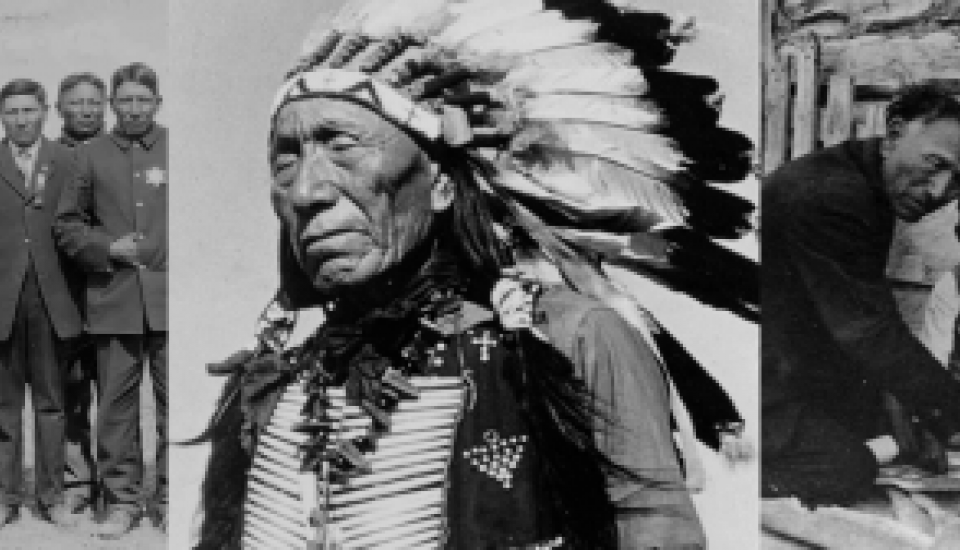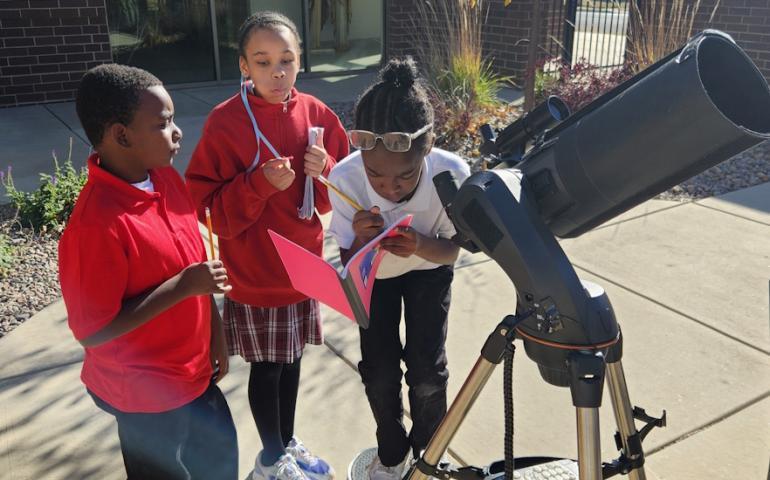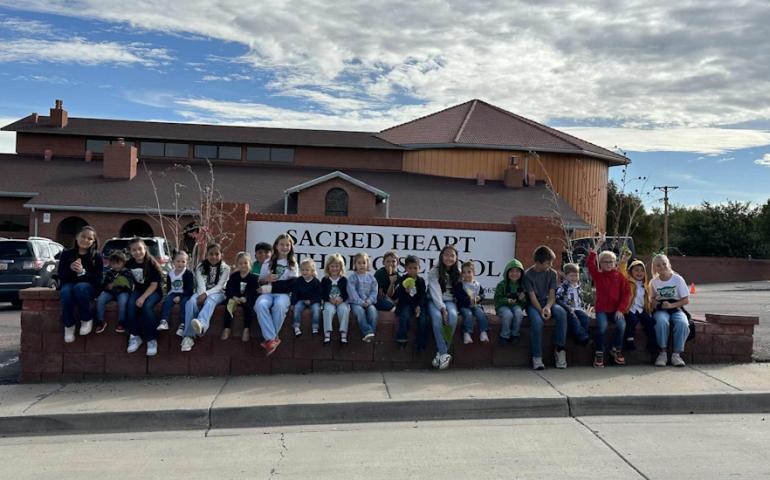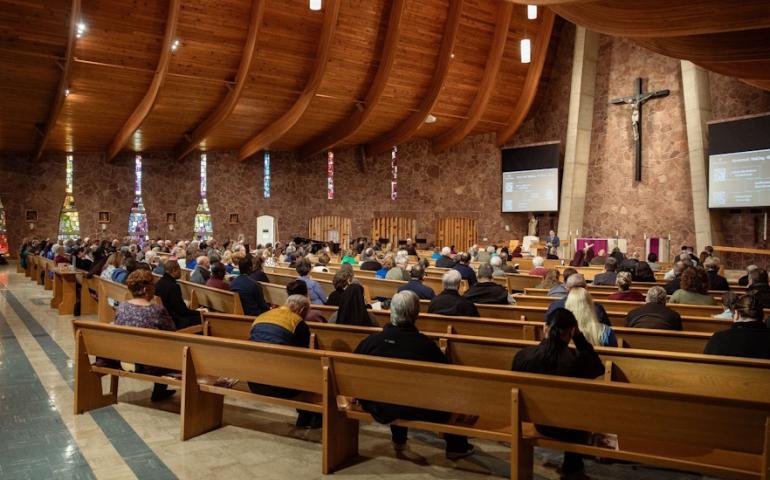
Highlights from the Holiness of Nicholas William Black Elk, Sr., 1860s – 1950
As a youth, Black Elk received a great vision to serve Wakantanka, the Great Spirit, and he became a great healer among the Lakota people. But called to serve more, he embraced baptism and Jesus as his savior, which he saw as fulfilling their way of life. Thereafter, over 400 native people heeded his call and were baptized as well.
During the 1860s, Black Elk was born into a lineage of medicine men. In 1872, atop Harney’s Peak in the Black Hills, he was favored by a great vision. Nine years later, his powers were confirmed and he became a healer and great medicine man at a very young age.
Curious about Christianity, he soon began to watch and study it. He learned about St. Kateri Tekakwitha, and in 1885, he signed a petition supporting the cause for her canonization (declaration as a saint). The next year with Buffalo Bill’s Wild West show, he went to Europe where he saw Christianity in action. In 1904, while praying through yuwipi for a boy’s healing, he met a Jesuit who invited him to study Christianity at Holy Rosary Mission, near Pine Ridge, South Dakota, on the Pine Ridge Indian Reservation. He did so, and was baptized Nicholas William on December 6th, the Feast of St. Nicholas, which provided him a Christian model of charity that resonated with his role as a traditional spiritual leader.
Believing that Wakantanka, the Great Spirit, had called him to greater service, he became an authentic Christian who intertwined Lakota and Catholic practices. He prayed regularly with his rosary and pipe and participated in mass and Lakota ceremonies, but he never practiced yuwipi again. In 1907, the Jesuits appointed him a catechist (teacher of Christian faith) because of his enthusiasm and excellent memory for learning Scripture and Church teachings. Like St. Paul, he traveled widely, he preached and told stories, and he wrote pastoral letters in Lakota with Bible verses on good Christian living that newspapers published for the people to read. Oftentimes he taught the faith by narrating a published picture map called the “Two Roads” (pictorial ladder catechism), which featured the “Good Red Road” and the “Black Road of Difficulties” in colorful graphics.
As an elder, he continued his advocacy for Jesus Christ and Lakota heritage. From his office, in the St. Agnes Church parish hall in Manderson on the Pine Ridge Reservation, he served as a catechist, but with less mobility. Today, that hall is named “Black Elk Hall” in his honor. During the summer months of 1927 to 1946, he narrated demonstrations of traditional Lakota life and ceremonies at a Black Hills tourist attraction. In 1930-1931 and 1947-1949 respectively, John G. Neihardt and Joseph Epes Brown interviewed him for Black Elk Speaks: Being the Life Story of a Holy Man of the Oglala Sioux and The Sacred Pipe: Black Elk’s Account of the Sacred Rites of the Oglala Sioux, two books with glimpses of his Two Roads and Black Hills narrations.
Just before his passing on August 19, 1950, he predicted that it would be marked by a sign. On the night of his wake at St. Agnes Church, the northern lights danced overhead with unprecedented brilliance. As a catechist, he was credited with leading over 400 native people to baptism, and since then, his books inspired many people. But he was not a stereotypical mystic, and only recently, most people have just begun to rediscover his complex dual commitment to Christianity and Lakota tradition.
Sources:
A Retreat with Black Elk: Living in the Sacred Hoop by Sister Marie Therese Archambault, Cincinnati, Ohio: Franciscan Media, 1998
Black Elk Speaks: Being the Life Story of a Holy Man of the Oglala Sioux, The Premier Edition, by Nicholas W. Black Elk; edited by John G. Neihardt and Raymond J. DeMallie, Albany, New York: SUNY Press, 2008
Catholic Ladder Pictorial Catechisms, Marquette University e-Archives: http://www.marquette.edu/library/archives/earchives_atoz.shtml; 1. Click on “In the Spotlight”; 2. Select issue, “Jan. 2009-Catholic Ladders Pictorial Catechisms.”
Nicholas Black Elk: Medicine Man, Mystic, Missionary by Michael F. Steltenkamp, University of Oklahoma Press, 2009; the principal source for this essay with Black Elk family interviews and perspective.
Pictures of Nicholas Black Elk, Marquette University e-Archives: http://www.marquette.edu/library/archives/earchives_atoz.shtml; 1. Click on any collection; 2. Click “Advanced Search”; 3. Enter keywords “Black Elk”; 4. Under “Searching collections,” add “Bureau of Catholic Indian Missions,” Holy Rosary Mission – Red Cloud Indian School,” and “In the Spotlight”; and 5. Click “Search.”
Photos:
1. Age ca. 42-45, undated (ca. 1907-1910): He prayed the rosary and taught his daughter Lucy Looks Twice to do likewise. She said that her father prayed his rosary often and held it when praying with his pipe [BCIM 00559].
2. Age ca. 62-63, 1927 or 1928: He taught the faith with the “Two Roads” picture map with the Good Red Road (red = Jesus’ blood) and the Black Road of Difficulties, Broken Nose cabin, Pine Ridge Reservation; Jesuit Father Eugene Buechel, photographer [SFM ITS 00042]
3. Age ca. 72, 1937: He dressed to teach tourists about Lakota ways, Duhamel Sioux Indian Pageant, Sitting Bull Crystal Caverns, Black Hills, South Dakota; W. Ben Hunt, photographer [WBH BCIM 01287].
4. After his passing, undated (1970s): His son Ben Black Elk prayed with his pipe at his grave, St. Agnes Church cemetery, Manderson; daughter Lucy and many scholars believed Black Elk was born during the mid-1860s, not 1858. Jesuit Father Paul B. Steinmetz, photographer [HRM-RCIS 02141].









